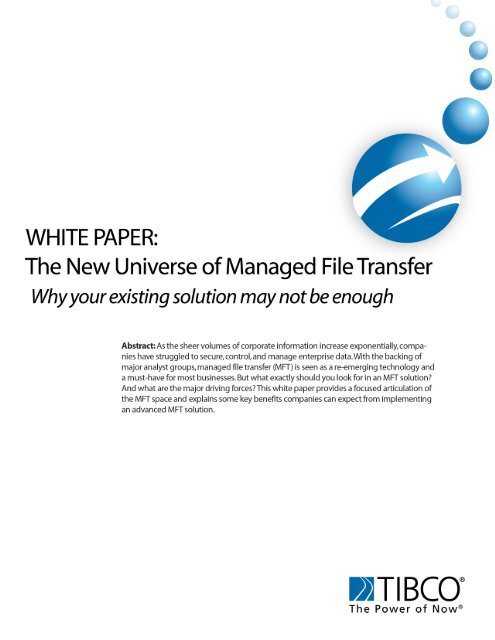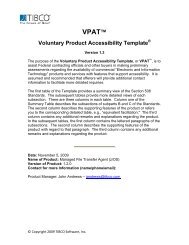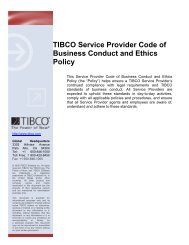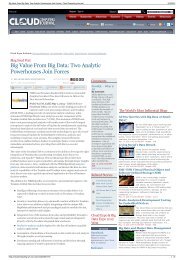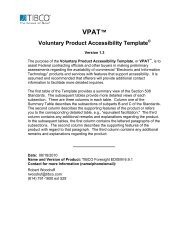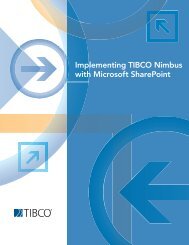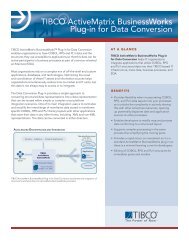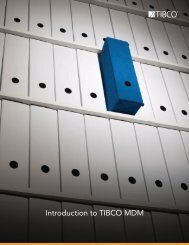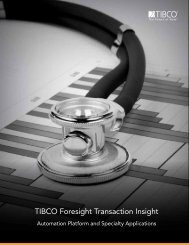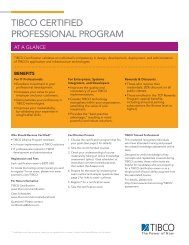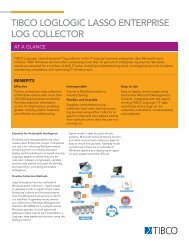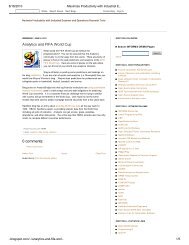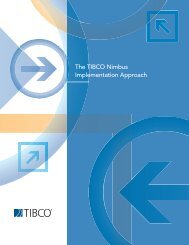CyberFusion Integration Suite - Tibco
CyberFusion Integration Suite - Tibco
CyberFusion Integration Suite - Tibco
Create successful ePaper yourself
Turn your PDF publications into a flip-book with our unique Google optimized e-Paper software.
Table of Contents<br />
1 INTRODUCTION: THE CHALLENGE .........................................................................................3<br />
2 THE EVOLUTION OF FILE TRANSFER .....................................................................................4<br />
2.1 MORE THAN JUST MOVING FILES ...............................................................................................4<br />
2.2 FILE TRANSFER – LEGACY ISSUES ...............................................................................................5<br />
2.3 DRIVING FORCES FOR ADVANCED MANAGED FILE TRANSFER......................................................8<br />
3 ADVANCED MANAGED FILE TRANSFER ............................................................................... 12<br />
3.1 WHAT TO LOOK FOR IN ADVANCED MFT.................................................................................. 12<br />
3.2 CONCLUSION ............................................................................................................................ 14<br />
4 ABOUT TIBCO .............................................................................................................................. 15<br />
WHITE PAPER: The New Universe of Managed File Transfer Page 2 of 15
1 Introduction: The Challenge<br />
Information management is a serious corporate challenge, and even the most<br />
efficient organizations can struggle with it. To be successful and meet the<br />
demands of today's business landscape, organizations must do everything in<br />
their power to secure and integrate their information assets, while satisfying<br />
compliance mandates and driving corporate efficiency.<br />
This white paper provides a focused articulation of the managed file transfer<br />
(MFT) environment – explaining the issues, challenges,<br />
and approaches that should be considered in order to<br />
address corporate information and data management<br />
requirements.<br />
The document's intent is to help executives and senior<br />
managers better understand major MFT issues, and to<br />
obtain insight into how to address the data protection,<br />
control and integration requirements of today's<br />
complex world. Managed file transfer is examined with<br />
regard to its increasing role in the corporate enterprise as a way to achieve data<br />
integration – a critical component of any corporate integration strategy. It<br />
assesses older, less-sophisticated technologies such as FTP, which fails to meet<br />
the demands of today's complex business landscape.<br />
Finally the document explains how, through the use of advanced managed file<br />
transfer (MFT), companies can address the most serious security and privacy<br />
concerns – including those raised by Congress (U.S.) with the introduction of the<br />
Specter-Leahy sponsored Personal Data Privacy and Security Act. Senator Leahy<br />
states that "It is time for Congress to catch up with the data market and to show<br />
the American people that we are aware of these threats and will protect the<br />
privacy and security of their personal information." He goes on to say that<br />
"Reforms… are long overdue."<br />
* * * * *<br />
Older, lesssophisticated<br />
technologies such as<br />
FTP fail to meet the<br />
demands of today's<br />
complex business<br />
landscape.<br />
From an IT and compliance perspective, reforms are also long overdue. The<br />
world of business has changed radically over the last decade. Organizations that<br />
proactively reform their data management infrastructures will prosper in this new<br />
world.<br />
WHITE PAPER: The New Universe of Managed File Transfer Page 3 of 15
2 The Evolution of File Transfer<br />
2.1 More Than Just Moving Files<br />
The term "file" when used in this document refers to an electronic file, the<br />
concept of which has been around since computers were first invented. It is<br />
helpful therefore to start with some basic definitions:<br />
File: an organized structure of similar data that can be made available to system<br />
users (including the system itself and its application programs) and capable of being<br />
manipulated as an entity (for example, moved from one file directory to another).<br />
File Transfer: the movement of one or more electronic files from one location or<br />
machine to another.<br />
Managed File Transfer: a technology that helps companies monitor, control, and<br />
secure all aspects of the movement of data (frequently, but not limited to, large bulk<br />
data) between any two entities.<br />
Advanced Managed File Transfer: the integration and management of all file<br />
transfers inside and outside an enterprise to satisfy security, regulatory, and<br />
business process requirements as they exist today, and as they are projected to<br />
evolve in the future. Advanced managed file transfer solutions must offer total<br />
control of all data transfers, including complete auditability, total security, full<br />
automation, and end-to-end processing.<br />
Ever since it became practical to connect computers together with some sort of<br />
communication facilities, file transfer has been one of the most commonly used<br />
software technologies across the world. Organizations of all types and sizes have<br />
come to rely on this technology for the exchange of file-based information<br />
between different IT systems.<br />
But basic file transfer technology is inherently limiting. Its capabilities are<br />
fundamentally inadequate. Regulatory issues and evolving corporate<br />
requirements place demands that the technology cannot satisfy.<br />
The truth is, many file transfer applications were designed as simple utilities, not<br />
as enterprise solutions. As a result, they lack the management, control, and<br />
integration capabilities needed to support today's complex and challenging<br />
business environment.<br />
Over the last decade, managed file transfer (MFT) solutions have evolved to<br />
address some of the security, integration, and control challenges. However,<br />
today's enterprises require more advanced MFT technologies – technologies that<br />
WHITE PAPER: The New Universe of Managed File Transfer Page 4 of 15
deliver enterprise-level automation and integration functionalities – while<br />
ensuring the security and integrity of all transferred data. These technologies<br />
must offer strong audit and reporting capabilities so that organizations can track<br />
and control all aspects of data movement within and across the extended<br />
enterprise – and externally with customers and business partners.<br />
2.2 File Transfer – Legacy Issues<br />
Most companies recognize the increased importance MFT technology plays in<br />
their enterprise. But, the ability of companies to adopt more advanced MFT<br />
solutions, and to address their myriad file transfer challenges, has been severely<br />
hampered by legacy issues. Three technologies, in particular, have been<br />
pervasive, and have led to hesitation and/or inaction when it comes to<br />
implementing new MFT technologies.<br />
These technologies are:<br />
File Transfer Protocol (FTP)<br />
In spite of being free and widely available, FTP imposes significant<br />
operational deficiencies, as follows:<br />
1. FTP security is weak and all passwords and data are sent in clear text<br />
format.<br />
2. The FTP protocol lacks mechanisms to determine if a transfer has been<br />
successful or has failed and in most cases cannot restart failed data<br />
transfers.<br />
3. FTP lacks automation features and provides only a manual interface.<br />
4. FTP does not compress data and requires a significant amount of<br />
network bandwidth and transmission time.<br />
5. FTP does not integrate easily with applications. There is only a manual<br />
interface that requires programming in a scripting language.<br />
6. FTP controls are weak. It does not allow operations to be tracked and<br />
falls desperately short with respect to audit and compliance.<br />
Outlook: FTP is inappropriate for enterprise file-transfer management and has,<br />
effectively, had its day. Its use in the enterprise will diminish greatly.<br />
Legacy File Transfer Applications<br />
These older file-transfer applications were developed in the early- and mid-<br />
1980's. These applications are installed and "entrenched" in major<br />
organizations around the world. The applications are based on very old<br />
technologies and the architectures are inadequate for today's complex<br />
business environment. Specific weaknesses include:<br />
WHITE PAPER: The New Universe of Managed File Transfer Page 5 of 15
1. Offer limited support for concurrent transfers (limit estimated to be<br />
technologies will continue in place but advanced systems for managed file<br />
transfer will continue to be adopted.<br />
Conclusion<br />
These legacy file-transfer technologies do not deliver the functionality required<br />
to be categorized as advanced managed file transfer. Principal failings include a<br />
fundamental lack of security, auditability, hands-off automation, and centralized<br />
management and control. A high percentage of organizations that depend on<br />
any of these legacy technologies are now giving serious consideration to<br />
advanced MFT.<br />
Accelerating market globalization, major advances in technology, and increased<br />
levels of security risk, have dramatically increased the importance of managed file<br />
transfer. In fact, managed file transfer has become the linchpin of data<br />
integration and application integration for many major enterprises.<br />
Simply put, effective MFT is an imperative for any organization with information<br />
at its core. With internal and external mandates demanding that business<br />
processes be documented, auditable, and accountable, companies are clamoring<br />
to wrestle back control of information-based business activity. MFT software<br />
empowers organizations to achieve this fundamental goal. While MFT<br />
deployments have been most prevalent in industries like banking, insurance, and<br />
healthcare, its adoption has now spread across all vertical industries.<br />
WHITE PAPER: The New Universe of Managed File Transfer Page 7 of 15
2.3 Driving Forces for Advanced Managed File Transfer<br />
The enterprise need for more advanced managed file transfer capabilities is<br />
compelling and driven by many factors. The most significant drivers include:<br />
• B2B <strong>Integration</strong> Requirements<br />
• Regulatory Compliance Mandates<br />
• Control & Management<br />
• Security<br />
• Open Standards<br />
• Efficiency<br />
Each of these drivers is important in its own right, but taken in aggregate, they<br />
escalate the importance of advanced MFT to the level of corporate imperative.<br />
B2B <strong>Integration</strong> Requirements:<br />
Over the last decade, the IT industry has placed enormous focus on the subject<br />
of integration, developing a range of new technologies to improve the levels of<br />
integration across all aspects of the business process. Some companies have<br />
adopted strategies that incorporate MFT as a key component of their B2B<br />
integration strategy, but many have not. But while there is some momentum, the<br />
level of activity is inadequate. Leading industry analysts predict that a high<br />
proportion of companies with 'homegrown' file transfer solutions will replace<br />
them with MFT suites. B2B integration requirements alone dictate that the pace<br />
of adoption must accelerate.<br />
Effective data integration requires the access, aggregation, and synchronization<br />
of data across multiple systems or databases. It is, for the most part, directly<br />
focused on the data itself. Therefore, data integration involves concern for the<br />
location and structure (syntax) of the data, as well as requirements for<br />
transformation of the data to suit the needs of the target database or<br />
application.<br />
Data integration is being pursued by using a wide variety of technologies, from<br />
simplistic adapters for data access, to batch-oriented file transfer mechanisms, to<br />
more sophisticated extraction, transformation, and loading (ETL) or replication<br />
tools. Enterprises must understand that effective data integration is not reliant on<br />
one solution. It takes many different tools and technologies to satisfy the<br />
integration needs of an organization. Key components common to all data<br />
integration scenarios include:<br />
• Connectivity & Access – reaching the data of interest<br />
WHITE PAPER: The New Universe of Managed File Transfer Page 8 of 15
• Transformation – which may include joining or merging of data, as well as<br />
aggregation<br />
• Delivery/Consumption – the mechanisms by which the data will be<br />
addressed by tools, applications or users<br />
• Metadata Management – for design and control of the integration process<br />
• Standardization – new standards have emerged that facilitate integration,<br />
including Web services for the Internet, open API's for systems<br />
integration, and data formatting standards for system compatibility<br />
Effective B2B integration requires a comprehensive technology architecture and<br />
strategy. An advanced MFT solution will play a critical role in this regard.<br />
Regulatory Compliance Mandates:<br />
Regulatory compliance is one of the most significant challenges facing businesses<br />
today. The issue is pervasive for everyone from the CEO and CFO down to IT<br />
Management and staff. These issues and challenges<br />
will only escalate over the next several years.<br />
Compliance mandates, including Sarbanes-Oxley,<br />
HIPAA, and GLBA, call for every process to be<br />
documented, auditable, and accountable. As a result,<br />
companies must examine how they secure, manage,<br />
File transfer<br />
management must<br />
be considered<br />
strategically rather<br />
than tactically.<br />
and control file transfers, and they must address all weaknesses. File transfer<br />
management must be considered strategically rather than tactically; it is integral<br />
to the success of the overall corporate mission.<br />
The bottom line? Regulatory compliance is much more than a best practice – it’s<br />
a requirement.<br />
Control & Management:<br />
With data driving global business, effective data management and control is an<br />
integral driver of business growth and success. Industry analysts predict that all<br />
companies, small, medium, and large will discontinue their current methods of<br />
sending and sharing data. Gartner, in particular is clear in its position, stating<br />
that: "In the immediate future, most companies, regardless of industry, need to<br />
consider how they are securing and managing their file transfers. They must<br />
discontinue using the older, unsecured, and uncontrolled methods of sending<br />
and receiving information. Homegrown solutions are commonly used, although<br />
many users acknowledge the limitations of these tools when applied in an<br />
integration context. Internal and external security, management, and integration<br />
requirements will force companies to scrutinize and consider replacements to<br />
their homegrown solutions."<br />
WHITE PAPER: The New Universe of Managed File Transfer Page 9 of 15
Scalability will be key as companies adopt new solutions. The use of an<br />
advanced, highly-scalable MFT solution will deliver better data management and<br />
control in the following ways:<br />
Management: secure, centralized management of all transfer servers<br />
regardless of platform or location. This must include an organization's<br />
ability to manage users across and beyond the enterprise, the ability to<br />
log all file transfer activity, and the ability to produce detailed audit and<br />
activity reports in real time. All of this functionality will typically be<br />
accessed from a single, unified interface. Alerts and event-driven<br />
notifications should also be part of the core solution.<br />
Control: a very important capability of MFT in the extended enterprise is<br />
the ability to control users both inside and outside the enterprise and to<br />
assign the appropriate privileges to users with the knowledge that access<br />
will comply with corporate and regulatory compliance mandates.<br />
Permissions can be granted or changed based on pre-assigned roles, and<br />
can be revoked in an instant, if necessary.<br />
Security:<br />
The vast public network we refer to as the World Wide Web has given businesses<br />
a powerful, inexpensive network on which to connect and do business. But as a<br />
completely public and open forum, the Internet is inherently insecure. And when<br />
it comes to the transmission of sensitive or confidential business information, it<br />
doesn’t always measure up.<br />
This has deep consequences for organizations with information movement at the<br />
core of their activities. Any enterprise that wishes to use the "free" network of<br />
the Internet must take extensive measures to protect any and all data being sent.<br />
The use of the Internet for B2B transactions is projected to grow five fold over<br />
the next three years. The reasons are simple – the cost of a transmission over the<br />
Internet is 1/100 the cost of a transmission over a dedicated network. Ease of use<br />
and universal access to the Internet offer tremendous opportunity to connect to<br />
even the smallest of business partners. In effect, the Internet is the largest<br />
network in the world and will continue to move more data than any other<br />
network. Businesses must take advantage of this incredible tool, but also ensure<br />
security and control as they do so.<br />
Beyond the Internet, security concerns and the requirements they place on IT<br />
systems and infrastructure have undergone the highest levels of change. The<br />
demands placed on businesses have increased dramatically over the last several<br />
years. Corporate data breaches, post 9/11 issues, and a growing public paranoia<br />
regarding identity theft are only the tip of the iceberg. Consequently, new<br />
security capabilities with multi-level authentication, firewall restricted access, and<br />
WHITE PAPER: The New Universe of Managed File Transfer Page 10 of 15
advanced encryption algorithms, have become integral to improving security<br />
systems. In the world of managed file transfer, none of the improved security<br />
measures are adequate unless the full process – from end-to-end – is managed<br />
and controlled. Manual and/or disjointed MFT processes cannot satisfy the more<br />
complex compliance mandates and business requirements faced today.<br />
Open Standards:<br />
One of the most significant issues regarding IT strategy in the past decade or so<br />
is the advancement of industry standards in all aspects of IT. These new<br />
standards facilitate integration, and including Web services for the Internet, open<br />
API's for systems integration, and data formatting standards for system<br />
compatibility. XML, SOAP, UDDI, WSDL, and STRUTS are key standards as are<br />
encryption standards like AES (Rijndael) and Blowfish. Open standards will be key<br />
drivers when it comes to enterprise integration.<br />
Organizations should deploy information and integration control systems that<br />
adhere to open standards and support a wide variety of operating environments<br />
and platforms. Proprietary solutions are not acceptable for today's enterprise;<br />
any new systems architecture must be based on open standards or it should not<br />
be deployed.<br />
Performance & Efficiency:<br />
Today's complex global relationships require tight B2B integration – where one<br />
organization can integrate tightly with dozens or even hundreds of others (such<br />
as partners, vendors, and other suppliers). A breakdown in these integrated<br />
processes can be crippling – and often costly (service-level agreements, etc.). An<br />
advanced MFT solution will automate many of the fundamental business<br />
processes across the enterprise – enabling seamless integration with other<br />
applications in the enterprise in support of mission-critical, business processes.<br />
With a full complement of tools and functions to support unattended, 'lights-out'<br />
operation, file transfer activity will be structured and easily scheduled, resulting in<br />
significantly less manual (and error prone) processes. This will make an<br />
organization easier to do business with. It will also enable the organization to<br />
redeploy resources toward more high-level or strategic activity, while day-to-day<br />
business processes run efficiently in the background. This delivers true end-toend<br />
processing to the organization and maximizes overall efficiency.<br />
The use of an advanced MFT solution will dramatically improve the overall<br />
strength of an enterprise and its ability to be agile and responsive in an<br />
increasingly demanding marketplace.<br />
WHITE PAPER: The New Universe of Managed File Transfer Page 11 of 15
3 Advanced Managed File Transfer<br />
3.1 What to Look For in Advanced MFT<br />
We've seen that there are many compelling reasons for moving to an advanced<br />
managed file transfer solution. But not all MFT solutions are created equal. An<br />
advanced managed file transfer solution's value proposition is underpinned by<br />
the following fundamental concepts:<br />
• Single Point of Control<br />
• Total Security<br />
• Total Auditability<br />
• Guaranteed Delivery<br />
• End-to-End Automation<br />
• Inside and Outside the Extended Enterprise<br />
What is Single Point of Control?<br />
A single point of control means you can impose absolute control over all data<br />
movement inside and outside the enterprise. Look for a centralized interface that<br />
serves as the single point of control for all files transferred – whether it be<br />
internally, across the extended enterprise, or externally with customers,<br />
suppliers, and business partners.<br />
What is Total Security?<br />
Total Security means security that is architected and engineered into every<br />
aspect of the solution. There should be comprehensive authentication and<br />
authorization for all users, servers, clients, and databases in the MFT network. In<br />
addition, each server should contain its own authentication and authorization<br />
schematics so that access can be restricted at a very granular detail. Encryption<br />
technologies are extensively used for internal system communications as well as<br />
for all file transfers. Delegated administration is another core function to look for;<br />
this will ensure that system administrators have powers consistent with their<br />
organizational role and security status.<br />
What is Total Auditability?<br />
In a typical organization, file transfer activity is happening 24x7, frequently at<br />
high volumes, and usually between parties that are spread across a broad<br />
geographic area. Your MFT system should log each and every transfer-related<br />
event at the local and central level, and produce detailed reports of every aspect<br />
of all transfers. In addition to a comprehensive set of detailed audit reports, it<br />
WHITE PAPER: The New Universe of Managed File Transfer Page 12 of 15
should provide an extensive set of online inquiry tools to support ongoing<br />
operational and management needs. Also look for a full set of real-time alerts<br />
that can notify personnel instantaneously as circumstances warrant. Having<br />
information about every aspect of every file transfer available enables an<br />
organization to achieve total auditability of enterprise file transfer, thereby<br />
satisfying regulatory compliance mandates in addition to helping guide<br />
corporate decision making.<br />
What is Guaranteed Delivery?<br />
Guaranteed delivery means that the data to be transferred is absolutely,<br />
positively transferred to its intended destination, and that the file arrives on time.<br />
This becomes critical in B2B relationships especially those contingent upon<br />
service-level agreements. Guaranteed delivery is only possible in advanced MFT<br />
systems, through the use of automated restarts, exception alerts, queuing,<br />
production-workflow balancing, and software reliability rates of greater than<br />
99.999%.<br />
What is End-to-End Automation?<br />
End-to-end is the uninterrupted transfer of data from an outside partner to deep<br />
inside the enterprise. End-to-end transmission facilitates integration with other<br />
applications (through rule-based processing) whereby files can be set up to<br />
automatically process upon receipt. To be truly end-to-end, the solution should<br />
not use a store and forward approach (this will eliminate the risk of having<br />
intermediate systems in unsecured networks such as the DMZ).<br />
End-to-end processing is a key requirement as it permits an organization to<br />
automate and streamline many of the fundamental business processes built<br />
around file transfer.<br />
What is Inside and Outside the Extended Enterprise?<br />
The word enterprise can encompass corporations, small businesses, non-profit<br />
organizations, government bodies, and other kinds of institutions. Larger<br />
organizations are often referred to as extended enterprises – whereby the<br />
organization has a global presence with locations in multiple cities, counties, or<br />
continents.<br />
Extended enterprises need to operate on an integrated infrastructure, and need<br />
to integrate efficiently with both internal and external organizations (outside of<br />
the enterprise). These can include key suppliers, manufacturers, business<br />
partners, and end-customers. An advanced MFT solution will provide the secure<br />
connectivity required to transfer files inside and outside the enterprise – and to<br />
do so across all platforms (Windows to Mainframe), as well as over the Internet.<br />
WHITE PAPER: The New Universe of Managed File Transfer Page 13 of 15
3.2 Conclusion<br />
All of the experts agree; MFT must be part of an organization's information<br />
strategy. Getting the data to the right place, at the right time, in the right format<br />
is critical, as is ensuring that the data is secure at every step along the way.<br />
But what are the key benefits of advanced MFT?<br />
You should expect that your MFT solution, deployed as part of an overall<br />
business integration strategy, delivers the following key benefits:<br />
• Security: complete data security and support for the world’s most<br />
stringent encryption standards.<br />
• Compliance: extensive auditing capabilities and compliance with current<br />
and evolving regulatory mandates (Sarbanes-Oxley, HIPAA, PCI DSS,<br />
Gramm-Leach-Bliley, etc.).<br />
• <strong>Integration</strong>: an open architecture and API support that allow seamless<br />
integration with enterprise applications and support of business process<br />
automation.<br />
• Automation: the end-to-end automation of many important steps and<br />
processes. For example, event-driven transfers that support real-time<br />
initiation of data movement across platforms. This is critical to support the<br />
fully-unattended, "lights-out" requirements at many data centers.<br />
• Flexibility: flexibility so that your organization can adapt to constantly<br />
evolving business requirements, thereby improving service delivery and<br />
trading partner relationships.<br />
• Cost Savings: process automation and efficiency gains throughout the<br />
enterprise, thereby reducing errors, manual effort, operating expenses,<br />
and people-intensive operations.<br />
The bottom line? More and more businesses are deploying managed file transfer<br />
to solve their data movement and B2B integration challenges. But not all<br />
solutions are created equal. Look for an advanced MFT solution that can handle<br />
internal and external file transfer requirements both over the Internet and across<br />
all platforms. Make sure the solution can scale to support your business. Finally,<br />
look closely at the vendors. The biggest vendor is not always the best vendor.<br />
Talk to the major analyst firms such as Gartner; they've got a good pulse on the<br />
market and can generally point you toward the best solution based on your<br />
needs.<br />
WHITE PAPER: The New Universe of Managed File Transfer Page 14 of 15
4 About TIBCO<br />
TIBCO Software Inc. (NASDAQ: TIBX) is a provider of infrastructure software for<br />
companies to use on-premise or as part of cloud computing environments.<br />
Whether it’s efficient claims or trade processing, cross-selling products based on<br />
real-time customer behavior, or averting a crisis before it happens, TIBCO<br />
provides companies the two-second advantage – the ability to capture the<br />
right information, at the right time, and act on it preemptively for a competitive<br />
advantage. More than 4,000 customers worldwide rely on TIBCO to manage<br />
information, decisions, processes, and applications in real time. Learn more at<br />
www.tibco.com.<br />
TIBCO Software Inc.<br />
200 Garden City Plaza<br />
Garden City, NY 11530<br />
T +1 (888) 333-7205<br />
F +1 (516) 535-3601<br />
www.tibco.com<br />
* * * * *<br />
©2010 TIBCO, TIBCO Software, and The Two-Second Advantage are trademarks<br />
or registered trademarks of TIBCO Software Inc. and its subsidiaries in the United<br />
States and/or other countries. All other product and company names and marks<br />
mentioned in this document are the property of their respective owners and are<br />
mentioned for identification purposes only.<br />
WHITE PAPER: The New Universe of Managed File Transfer Page 15 of 15


